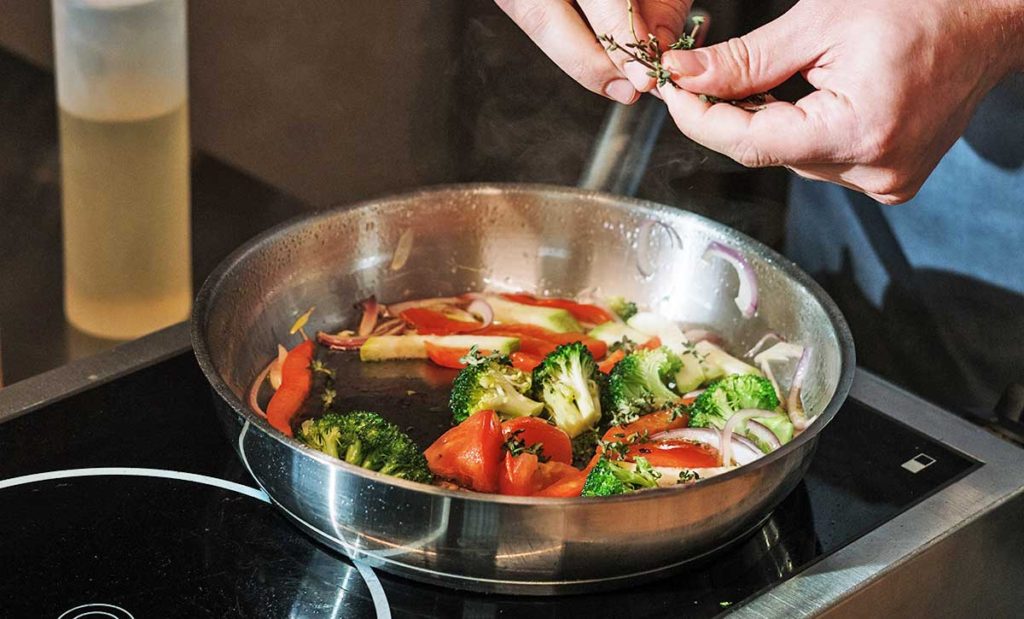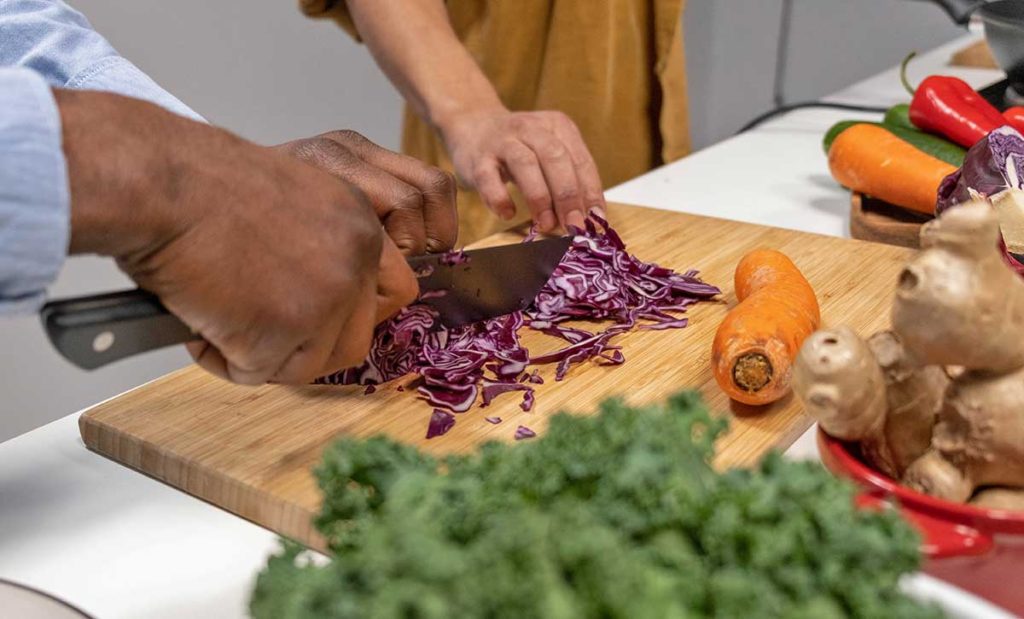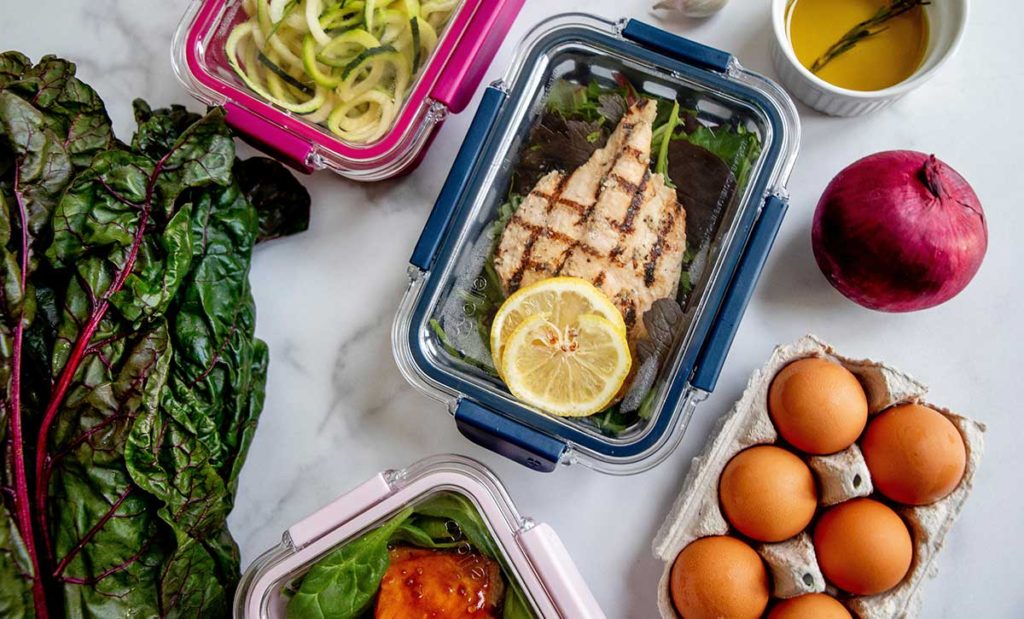Last Updated on November 17, 2023 by Cathy

Living with multiple sclerosis (MS) is no easy task. Let alone trying to cook a nutrient-dense healthy meal three times a day. If you struggle with balance or weakness, standing at the kitchen counter for an hour or more is not an option.
Fortunately, there are tricks you can use to help speed up the cooking process when cooking at home. Not only will you have your meal done quicker you won’t feel exhausted by the time you’re done.
Eating at Home
More people are eating at home today than even 10 years ago. Between more people working from home and eating healthy, people are staying home. Plus, with the convenience of streaming your favorite TV show or movie, it’s more appealing.
When it comes to food, health and wellness are leading the food market. I remember when I first started eating healthy back in 2004, there was very little available. My grocery store had a tiny aisle of “natural foods” and a pitiful selection of organic produce.
I had to shop at a local health food store long before Natural Grocers or Whole Foods was available. Now you can have just about anything you need to be delivered straight to your door. From pantry items to meats you don’t even need to step into a grocery store.
The trick to saving time and energy when cooking at home is… planning. Yes, planning makes all the difference. I’m not talking about planning every meal, every day. And I don’t mean large batch preparations that take hours. That’s too is too much work when you have MS.
I’m talking about smaller steps so you don’t get tired.
Living with MS you need all the shortcuts you can find to make your life easier. Meal prepping will keep you from stopping at a fast-food restaurant. Plus, it will lower your stress of not having to do everything at once.
Where to Buy Food Prep Containers
My favorite food storage is glass, I have several Pyrex dishes in different sizes. You can cook your food in it, freeze it, and eat out of it. I’m kind of a minimalist so I don’t like having a lot of stuff.
However, glass isn’t a good option if you are using it for your lunch going to work. Instead, I use BPA-free reusable plastic containers. They are lightweight, inexpensive, and have plenty of room for food.
Never microwave or store hot food in a plastic container, even if it is BPA-free. Some manufacturers use Bisphenol S (BPS), which is just as toxic if not more.
I purchased these food containers from Amazon.
Meal Prepping

The first tip is to always make a double batch of whatever you’re cooking. You can either save it for lunch the next day or freeze it for another day when you’re busy or too tired. When freezing it make sure you label it and date it to keep it from getting freezer burned.
Some foods you can’t freeze. Like leafy greens, high water content foods like celery, cucumbers, or radishes. Coconut cream-based soups, gravies, sauces, and fried foods also don’t freeze well.
Start your week with just a few prepped meals. Or prep a few ingredients to help speed up the cooking process later. By prepping I mean wash, dry, peel (if appropriate), and chop up. To prevent them from drying out, place a damp paper towel on top and store it in an airtight container.
You can also blanch vegetables 1-2 days in advance. Blanching is boiling them in salt water until tender. Then place it in ice water to stop the cooking process.
Sulfur vegetables are great for prepping now to use later. When you have cabbage, broccoli, or cauliflower chop it up and store it in a ziplock bag. Then when you are preparing a meal or salad you can grab what you need toss it in and you’re done.
Don’t refreeze uncooked meat. It is safe to eat but it loses its flavor.
Keep It Simple

Avoid recipes with a lot of ingredients, the fewer the better. Don’t buy something where you only use a small amount, like a teaspoon. Instead, find something you already have and substitute it, this will save you money.
Choose two or more recipes with the same ingredients. You don’t have to cook both recipes on the same day but if they both have broccoli, chop extra for both recipes. That saves you time and energy on the second recipe.
When putting a meal together think of the rainbow with colorful fiber-rich veggies. Include a lean protein, nutritious carb-like butternut squash, and a little healthy fat.
How to Prep Veggies
Asparagus: washed, trimmed, and stored up to 2-3 days in advance. Store in an airtight container or resealable bag in the refrigerator.
Carrots: peeled, chopped, or shredded up to 2-3 days in advance. Store in an airtight container in the refrigerator.
Broccoli and cauliflower: washed and cut into florets 2-3 days in advance. Store in a sealed bag or airtight container in the refrigerator. Warning, cauliflower will oxidize if exposed to air so wrap it tightly.
Brussel sprouts: they dry out quickly so it’s best to prep these at least one day ahead of using them.
Cabbage: washed then chopped, sliced, or shredded 1-2 days in advance. Store in an airtight container in the refrigerator.
Celery: dirt hides in celery so thoroughly wash then chop 3-4 days in advance. Store in an airtight container in the refrigerator.
Bok choy: dirt gets hidden inside so chop off the bottom and wash it thoroughly. You can chop or thinly slice it 3-4 days in advance. Cut baby bok choy in half or in quarters. Store in an airtight container in the refrigerator.
Garlic: peeled and the whole cloves stored in a glass jar or sealable bag for 7-10 days.
Leafy greens: washed 2-3 days in advance. For tender greens such as romaine lettuce or spinach allow it to dry for a few hours. For thicker leafy greens such as beet greens or collard greens cut, slice, or tear up to 2-3 days in advance. Store all leafy greens in a clean bag in the crisper drawer.
Onions: chopped or sliced 1-2 days in advance. Store them in a tightly sealed glass container or double resealable bag to keep the orders in.
Sweet potatoes: scrubbed or peeled and chopped 3-4 days in advance. Store in an airtight container or sealed bag in the refrigerator.
Zucchini: washed then chopped, sliced, or shredded up to 2-3 days in advance. Store in an airtight container or sealed bag in the refrigerator.
Cooking at Home

To save time and energy when cooking at home keep it simple. Don’t turn your meals into a huge event or you will quit. Or you may skip meals because you’re too tired. Trust me, I’ve been there.
Start with a simple recipe or throw different kinds of veggies into one skillet and cook everything at once. Lunches are easy, use leftovers from the night before. One of my favorite meals is Easy One-Pan Rosemary Chicken With Veggies.
Here are some easy meals you can prepare early:
- Casseroles
- Most meat dishes (either whole or ground meat)
- Most fish dishes (choose firmer fish like salmon, tuna, herring, mackerel, shrimp)
- Pestos
- Roasted or blanched vegetables
- Soups
- Stews
- Sauces
Doing something simple like doubling your recipe or chopping up extra veggies to use tomorrow will help.

Free Wellness Library!
Subscribe for free and I’ll send you the password to my secret library filled with many printables for your wellness journey.
Want to remember this health tip? Pin it to your Pinterest board!

Photo by cottonbro and Katerina Holmes from Pexels, and Ello on Unsplash.
Save Time and Energy When Cooking at Home





